Black Bullet
Among the variety of designs being developed were Bell P-39 and Curtiss P-40, which in no way exceeded the German Bf-109, Hawker Hurricane and Supermarine Spitfire, which are currently in service with the countries of Europe. The only project that grew up in a first-class fighter a few years later was the XP-38, the P-38 prototype "Lightning", which was put on the conveyor was quite long and complicated, since the first XP-38 prototype was broken during landing on the Mitchel airfield in New York 11 February 1939 of the year.
Aware of their weakness, the US authorities began a comprehensive development aviation. The plan of the Ministry of Defense provided for the development of one or more fighter aircraft, the mass production of which was planned for 1941 and 1942. Special government loans were issued that allowed for the development and production of new types of aircraft when they were selected. Such an approach to financing the modernization of the fighter fleet allowed, in the end, to achieve the necessary results.
9 June 1939, the Air Force submitted a report to the Ministry of Defense, which called for two main directions for the development and implementation of modern monoplane fighters. In fact, this report dealt with two orders:
1. Two copies of at least three different aircraft with a speed of 684 km / y at an altitude of 4 572 meters (15 000 feet), representing a deep modernization of mass-produced vehicles;
2. Two copies of two different models capable of reaching speeds of 845 km / h at a height of 4 572 meters (15 000 feet), which are completely new developments.
One prototype from the first paragraph should have been used exclusively for flight tests. As the necessary flight data were obtained, the second prototype was to be equipped with a complex of necessary armament and equipment.
The main issue in this whole idea was the timing, because it was about launching aircraft into production, significantly surpassing all the analogues available at that time, and at the same time the financing of production was immediately allocated to the budgets of 1941 and 1942.
17 July 1939, Colonel JWSchulz, appointed by the Ministry of Defense responsible for the projects, made his first proposals for new aircraft, the projects of which were to be submitted to the Air Force. 7 August 1939 of the Air Force issued an order 39-770, and 13 September 1939 of the year began substantive negotiations with the three manufacturers, who put forward the most appropriate development proposals. These companies were Curtiss-Wright, Republic Aviation and Douglas Aircraft. Further, all this resulted in two contracts - Curtiss-Wright XP-46 (Future P-40) and Republic Aviation XP-47 (future P-47 "Tunderbolt"). Only negotiations with Douglas Aircraft ended without result.
Everything developed according to the plan of the USAF - only the third prototype was missing. That is why in February 1940, the Commander-in-Chief of the Air Force, Major General Henry H. "Hap" Arnold, requests the Ministry of Defense permission to issue the R-40C technical specification, which deals with the development of three vehicles with the highest possible flight characteristics, with full permission for experiments . In fact, it was a question of filling one of the three models with the “dropped out” participant Douglas, while proposing something completely new. The remaining two developments thus became purely experimental.
The green light on the R-40C implementation was given on 9 February. The technical assignment (on which, by the way, the confidentiality stamp was on) was sent to the 20 development companies in February 1940. The military expected initial designs from eight to ten companies, but in reality, the number of projects was 25, and they came from seven different companies (Vultee Aircraft Inc., two divisions of Curtiss-Wright Corporation, Northrop Aircraft Inc., Bell Aircraft Inc., Republic Aviation Corporation and McDonnell Aircraft Corporation). The Air Force Technical Commission examined all the 25 options offered, and on May 15 of the year 1940 issued its opinion on the three most interesting developments. This conclusion was confirmed by the Air Force Development Commission, which met on May 10, 20.
So, in general, the following three projects were selected:
1 - Vultee Model 70
2 - Curtiss-Wright Model P-249-C
3 - Northrop Model N-2B
All three were declared winners of the competition, and, despite completely advanced concepts, an order was issued for the creation of flying samples for the 1942 year. By the way - all three vehicles were built, but none of them was launched in the series. The 70 Vultee Model has grown over time with the XP-54 Swoose Goose, the Curtiss-Wright Model-249-C has become the XP-55 "Ascender", and the Northrop Model N-2B has grown into the Black Bullet XP-56.
31 May, after the announcement of the winners of the competition, the Air Force began negotiations with the winning companies. The first contract was signed with Northrop - 22 June was the first tranche of 11 000 dollars for full-blown tests in a wind tunnel. The contract also provided for the manufacture of a single copy of XP-56 at the price of 361 500 dollars, or two copies with a price of 220 000 dollars each. The US Air Force should have determined the number of samples ordered within nine months.
All three winners were characterized by a rear-mounted propulsion system and a pushing propeller. This was not some mandatory requirements of the R-40C specification, but the designers, without saying a word, chose this scheme for a number of objective reasons:
- air currents not disturbed by the propeller flow around the fuselage better;
- review from the cockpit is significantly better;
- it is possible to install in the nose of the aircraft heavy weapons;
For all three projects, the same liquid-cooled engine was provided - Pratt & Whitny X-1800-A3G, with a capacity of 2200 hp. The choice of such an engine was not accidental, since, according to the R-40C's terms of reference, the aircraft must be equipped with a new engine, which should appear within the next 10-18 months and which will have sufficient power to achieve the requirements of the task.
As Pratt & Whitnet was struggling to fine-tune its X-1800-A3G, Norhtrop developed a version of its XP-56 with a Pratt & Whitney R-2800 air-cooled twin 18-cylinder star engine. Of course, for such an engine, it was necessary to change the contours of the fuselage, as well as to strengthen the landing gear. It should also be noted that this engine was, by that time, at the final stage of refinement.
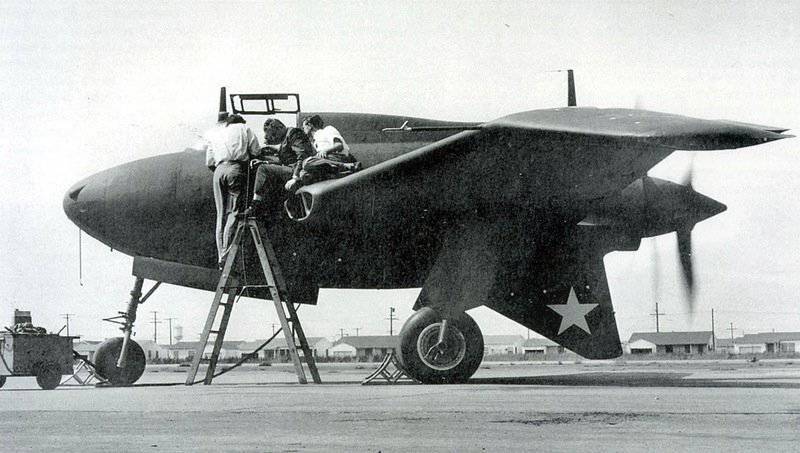
Aerodynamic testing began on September 9 with a purge layout on the 1 / 5 scale. They passed through a low-capacity wind tunnel in the laboratory of the Guggenheim Technological Institute of Califronia. The results of the first studies were positive, however, the blowdown had to be interrupted because the mock-up was seriously damaged due to the breakage of the attachment cables.
On September 26, 1940, in accordance with the terms of the assignment, the customer requested a full-size mock XP-56 to be prepared within the next 120 days, as well as one XP-56 as an "experimental single interceptor fighter" with a delivery time of 12 months. The aircraft was to receive serial number 41-786, and the total amount of the contract increased to 393 US dollars. By this time the situation with the engine was becoming more and more incomprehensible. The developers planning to use the Pratt & Whitney X-390-A1800G increasingly doubted the possibility of obtaining one. The absence of such a powerful engine called into question the implementation of the R-3C technical task for all development companies without exception. In such a situation, the Air Force ordered to accelerate the development of an alternative Pratt & Whitney R-40 engine, which, by this time, had already become the main engine in Northrop for its XP-2800. Of course, in such conditions, Pratt & Whitney announced the impossibility of further fine-tuning the X-56-A1800G (not surprising, no?) And focusing all its efforts on the R-3.
On October 3, a meeting took place between Jack Northrop and Parkins (a spokesman for the engine company Pratt & Whitney), at which they discussed the difficulties associated with installing the R-2800 on the XP-56. During this meeting, Parkins assumed responsibility for further development of the push engine, additional cooling, and crankcase adaptation to XP-56 requirements. Only the problem of additional cooling by passing air through special sinuses in the fuselage remained unresolved - this problem was to be dealt with by Northrop. As for the timing, the aircraft developer expected to receive the first finished engine sample within five months, while the engine manager named ten months as the minimum deadline. Ultimately, the parties agreed that Northrop would receive the Pratt & Whitney engine as soon as it was ready, with the engine engineers directing all efforts directly to the R-2800.
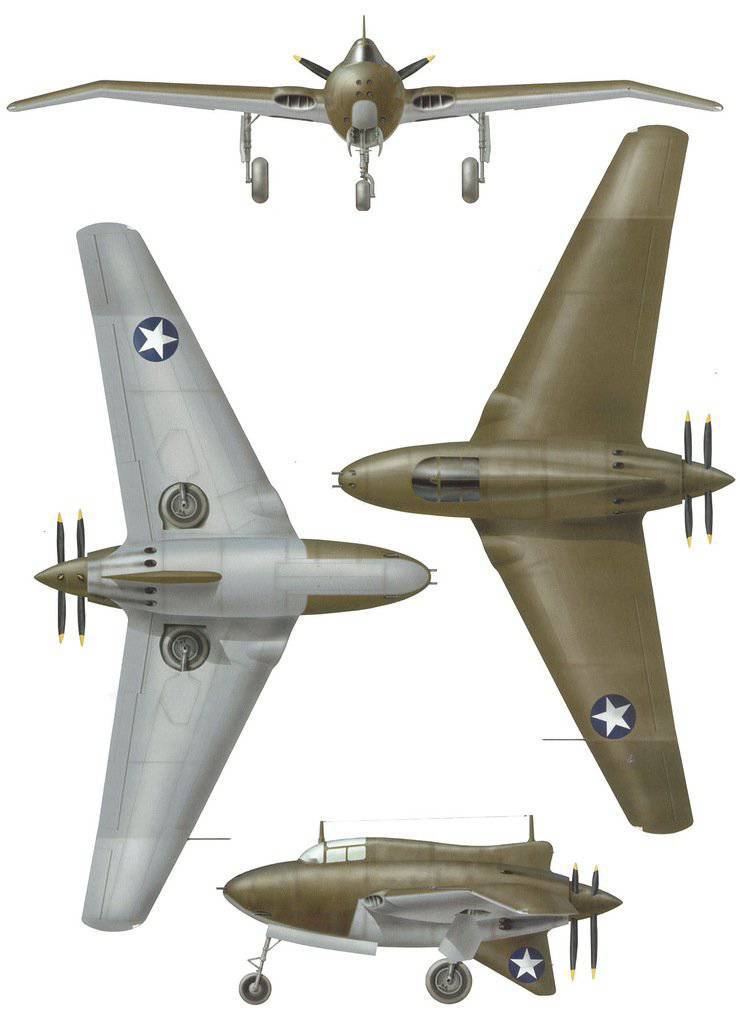
The Air Force, however, did not agree with this decision - they still hoped to obtain a liquid-cooled engine that could be installed on promising aircraft models. Pratt & Whitney, in turn, said that work on the R-2800 radial engine will not allow the X-1800 to be completed and this project will be postponed indefinitely. The XP-56 thus pulled ahead and became the only aircraft equipped with a radial engine. By the way, the rest of the prototypes eventually received liquid-cooled engines - the XP-54 received the Lycoming XH-2470-1, and the XP-55 was equipped with the Allison V-1710-95.
The second part of the contract was signed on July 21, 1941. The contract stipulated the government's inability to supply the required Partt & Whitney-1800-A3G, and Northrop took steps to replace the engine and prepare a version of the machine with the R-2800-23. Modified in this way, the XP-56 is to be delivered on May 15, 1942, or 75 days after Northrop receives the required engine. This engine eventually weighed the plane by about 1000 kilograms and reduced its top speed by 24 km / h.
After almost a year that has gone into solving such problems, Northrop XP-56 has finally found a much-needed engine. The final delivery time indicated in the contract was shifted to five and a half months, which more or less compensated for the time spent on working out issues with the power plant. The developers of "Black bullet", meanwhile, continued their work. 15 On July 1941, the XP-56 layout was provided to a commission of eight high-ranking officers and experts from the Air Force. The final report required many changes to the design and was written almost entirely in minor tones.
The main note was the landing gear, located far from the center of gravity of the aircraft. In passing, we note that the mandatory replacement of the radio to the most modern model, SCR-274-N, was ignored, as this would lead to serious changes in the design of the aircraft fuselage. In spite of all the above, in general, the commission recognized the model of the aircraft as satisfactory, and 12 of September expressed its official opinion. Air Force Brigadier-General Oliver P.Echols, appointed chairman of the commission, demanded that the sample be submitted for flight tests as soon as possible, since he really wanted to know if the prospective fighter is capable of taking its place in the army, and whether the air-cooled engine will really be able to issue characteristics that exceed the characteristics of engines with liquid radiators.
By the end of 1941, the XP-56 project was well advanced. All the troubles with the engine are in the past, the Air Force gave the green light to produce a prototype N1-M (prototype - flying wing), and this very prototype immediately began to demonstrate all the flaws of the concept of a flying wing with a pushing propeller ...
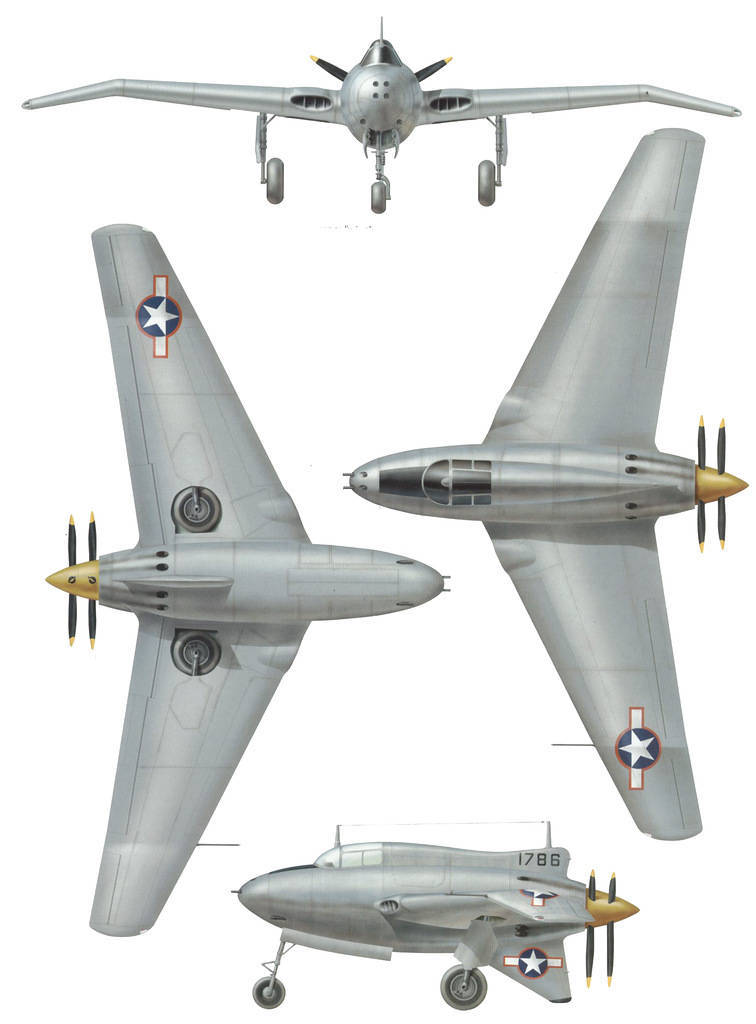
DELIVERY DELAYS
For a long time, Jack Northrop tried to interest the USAF with the ideas of a "flying wing". This was a truly revolutionary form, which was in sharp contradiction with everything that had been developed at that time in aviation. If XP-56 could not be called a real "flying wing", then at least many elements belonging to this type of aircraft were present in its design: a pushing engine, a negative wing V-shaped, developed slats and flaps ...
His hour came in September of 1941, when the Northrop factories were visited by the generals Echols and "Hap" Arnold, as well as the new US Under Secretary of Defense Robert Lovett, who were greatly impressed by what he saw. Echols congratulated the Northrop development team and conveyed to them an oral proposal for using the “flying wing” concept in the development of an ultra-long bomber, the terms of reference for which under the heading MX-140 were just in the final stages of development. The result of this specification was B-36, which was in production from 1949 to 1959 for the year and used by the US Air Force's Strategic Air Command. Made Northrop and prototype XP-35, which was a classic flying wing of a giant size, equipped with four engines. This was the final point in twenty years using the flying wing scheme of the legendary Jack Northrop.
The presence of such a promising bomber was very important for the United States Air Force, which increasingly understood the inevitability of war with Nazi Germany. Britain risked not standing alone the brunt of the war, and in this case the Americans would have to bomb objects in Europe from their airfields in the United States, and only the future MX-140 bomber could provide such a range.
The Air Force rightly feared that Northrop would not be able to fully focus on the XP-35 prototype, as it would be busy with the XP-56 project. However, the order for the XP-35 was still sent to the manufacturer in January 1942. As for the XP-56, after two months of painstaking negotiations, on February 13, 1942, a contract was signed for the construction of two prototypes. Over the next year, construction began, and Pratt & Whitney, having once again experienced difficulties with the production of the R-2800 and its adaptation kit for the XP-56, delayed the transfer of two prototypes to the Air Force. Pending the necessary engines, Northrop made incremental improvements and changes to the original design, until finally, on March 20, 1943, the first prototype was fully completed and submitted for testing.
PLANE WITH UNUSUAL SILHOUETTE
With its short, thick fuselage and massive wing, the plane stood out against the background of its classical counterparts. Elliptical air intakes in the roots of the wing fed both the carburetor and the engine cooling system. The cooling air accumulated in the compression chamber, from where a large fan, having a diameter almost coinciding with the diameter of the fuselage and located just behind the cockpit, was fed to the cylinders. After passing through them, the air went out through adjustable ducts, located in a ring in the area of the propeller.
The wings of the aircraft had a transverse V of nine positive degrees, and the wing tips were the same nine degrees deflected in the opposite direction, that is, they had a negative V. This design provided a significant improvement in the longitudinal and lateral stability of the aircraft, and for better maneuverability the aircraft was equipped with powerful slats and flaps. In order to ensure the same stability, the keel was placed on the underside of the fuselage, leaving only a small continuation of the gargroth with the radio antenna on the top. The front edge of the wing throughout the span was a fuel tank, limited to the front spar.
Engine "Black bullet" developed power in 2000 hp on takeoff and 1650 hp at an altitude of 7500 meters. Two propellers of opposite rotation each had three blades, while the screw closest to the pilot had a diameter of 2,95 meters, and the far one had a diameter of 2,89. In order to provide the pilot with the ability to safely leave the aircraft, the propellers were equipped with an ejection system in the air.
Armament on the prototype was missing, but, according to the developers, on the XP-56 four Browning M-2 machine guns in 12,7 mm caliber with 400 ammunition on the barrel and two 20-mm Hispano-Suiza M-2 guns with ammunition in 100 shots on the barrel. All the weapons were planned to be installed in the nose of the aircraft, and the Type N-2A telescope was located in the cockpit.
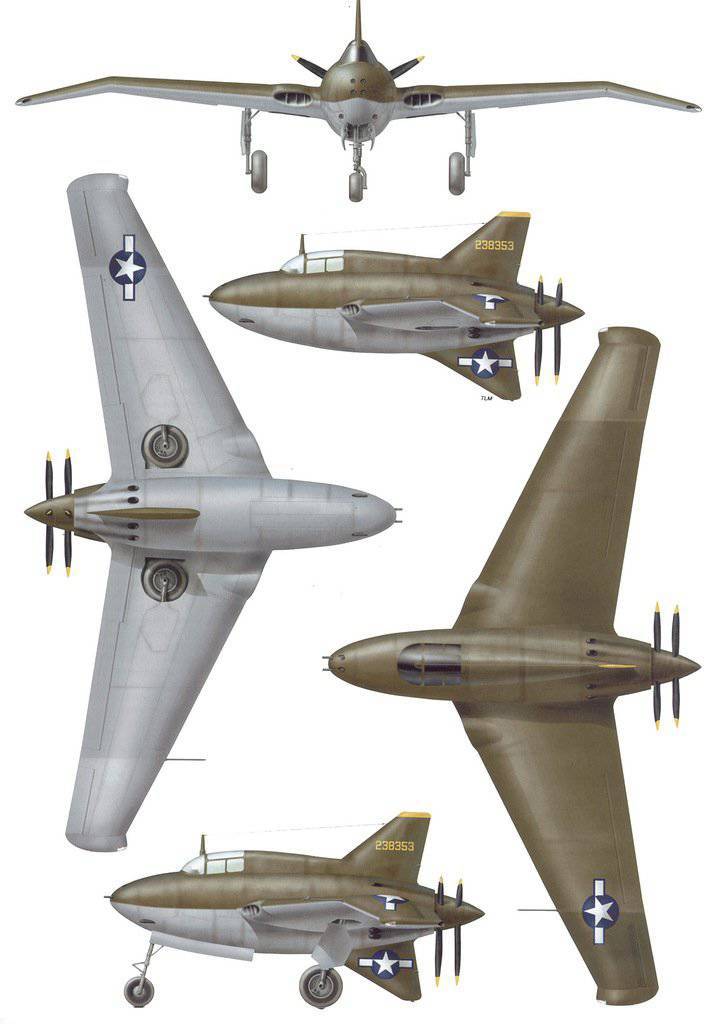
TESTS
The first flights took place on 6 April, and immediately showed a dangerous tendency to yaw and roll over when taxiing at high speed. Approaches were suspended, changes were made to various components and assemblies, after which the aircraft was prepared for dispatch to Muroc, where official tests were to take place. However, at an extreme moment, information was received that a fully prepared Pratt & Whitney R-2800 engine crashed during tests in Connecticut - a propeller blade was torn off from the power plant. If this happened in flight during the tests, the consequences would be dire, and in order to avoid this in the future, Northrop ordered a ground test cycle of the aircraft assembly - the engine, transmission and vibration level of the propeller were studied. These tests bore fruit - it was then that it was revealed that the shaking appeared at the moment the torque was transferred from the engine to the propellers. The engine was damaged due to such a strong shaking, and its replacement again postponed the date of the start of official flight tests. Taking advantage of this delay, Northrop redesigned the propeller drive assembly.
The first flight, originally scheduled for 11 or 12 on May 1943, took place only on September 6. On this day, the XP-56 41-786 was piloted by the commander of the test pilot group of the company Northrop John W.Myers. The plane broke away from the flat surface of the dried-up lake Rogers. The only drawback revealed during this test flight was the revealed dive tendency, which had to put a lot of effort into parrying the apparatus’s steering wheel. On the same day, Myers flew out a second time. The speed during these flights did not exceed 270 km / h, and the landing became quite hard and risky. Northrop engineers came to the conclusion that the reason lies in the lack of stability and yaw of the car, which was due to the insufficient size of the vertical tail. After that, the keel at the top of the fuselage was increased by 0,4 square meters. The results of these tests were taken into account when completing the construction of the second prototype, on which a full-fledged keel with a total area of 1,5 square meters was installed at this location. Another problem also emerged - the released nose landing gear was the cause of a strong bump and sharply reduced the stability of the aircraft in flight.
The finalized xP-56 re-entered the 8 test on October 1943. Before the third full-fledged flight, Myers conducted a series of so-called "approach". Numerous simulations of takeoffs and landings, as well as taxiing at high speed, were carried out all on the same dried lake. During the second day of testing, the pilot flew a distance of 3 kilometers at an altitude of 2-3 meters above the ground. With the next attempt, he covered a distance of a kilometer 3 at an altitude of 6 meters, but a strong gust of wind triggered a "bumpiness" during the execution of this test flight. To report this to the developers, the pilot decided to return to the starting point, and then once again repeat the flight at a higher altitude.
At the end of this test flight, when the plane had already touched the ground, it was sharply thrown to the left. Myers unsuccessfully tried to fend off this shot, but by this moment the left wheel could not stand it and exploded. At a speed of about 200 km / h, XP-56 made two bows, then jumped to a height of about 25 meters, then landed on its back, turning into a pile of twisted metal.
When the dust cleared, Myers appeared in the blood about three meters from the pile of debris. In the process of the aircraft tumbling, the pilot, strapped to his seat, flew out of the plane, smashing the cockpit glass with his head. The life of a tester was saved by a polo helmet that was the talisman of Myers. The pilot constantly wore this helmet, which he had not parted from the time of his game for the team at Stanford University.
The investigation revealed that the cause of the accident was a rupture of the left pneumatic tire, which had an increased load due to the sudden throw of the aircraft. As a "response" to the next prototype, new pneumatic tires made of rubber and nylon were put in place, replacing the cotton surface. Also on the second prototype, an oversized keel was installed, in front of which additional air intakes were placed, directing the air flow directly to the rudder. The center of gravity of the aircraft was shifted to the nose, which led to an increase in the stability of the aircraft both on the taxiing and on the take-off and landing modes. Completion of work on the second prototype was scheduled for the end of November, but all of these additional changes delayed the delivery of the aircraft until January 1944.
The tests of the second prototype began with the steering wheels in Hawthorne, during which the rudder was tested, as well as the strength of the new tires. The tests at Muroc were constantly shifting as the rainy season came, and the bottom of the dried lake looked like a big muddy puddle. Only at the end of March another lake - Roach Lake - was dry enough and became suitable for completing the tests. Northrop transports XP-56 to this lake with a mobile repair team and a powerful radio station. 22 March 1944 second XP-56, piloted by Harry Crosby, rises on its first test flight. Painted in olive and gray, this aircraft very much resembled a “black bullet” with its dark and swift, very unusual silhouette.
With its total weight of more than 5300 kilogram, the aircraft had a separation speed in the area of 260 km / h. Crosby, like Myers earlier, reported excessive loads on the control stick, and that, despite the installed compensators, the control stick on take-off had to be pulled with all his strength with both hands. But at the same time, in flight, the steering wheel turns excessively sensitive to the slightest movements of the control stick. The pilot made the landing seven and a half minutes after take-off, and it was caused by a malfunction of the fuel consumption sensor. The reason for the reluctance to take off, as well as the cause of the longitudinal instability, was determined fairly quickly - the center of gravity of the apparatus was moved too far forward, and taking up ballast characteristics, the engineers quickly achieved the desired result.
After carrying out all the necessary improvements, the second XP-56 prototype took to the 31 March 1944 of the year. During this flight, Crosby climbed to 1500 meters, and then proceeded to clean the chassis. As a result, the plane suddenly lost speed, decreasing from 270 to 190 km / h, and began to lose control. To regain control of the aircraft, the pilot had to urgently release the landing gear, then activate the system of slats and flaps, and then repeat the attempt to fold the landing gear. In this form, the aircraft accelerated to 320 km / h at an altitude of 2600 meters, after which the pilot felt strong vibrations on the right side. Rightly believing that reaching the 400 km / h speed in such conditions would be extremely dangerous, the pilot proceeded to land. The total flight time was thirty five minutes.
The speed achieved on XP-56 was far from the km / h requested by the 744 task. Throughout April and half of May, Crosby tried to achieve the desired result by completing four more flights on Lake Roach Lake. 12 May 1944, for the implementation of its seventh flight, XP-56 was transported from the territory of Roach Lake to Lake Harper. It should be noted that the manufacturer did not manage to eliminate the problem with too much effort on the control stick, since the source of all these problems was not detected. After two more flights, the plane was transported from Lake Harper to the Northrop plant at Hawthorne. 11 August 1944 of the year XP-56 flies to the Muroc training ground - and this turns out to be its tenth and final flight. Crosby during the takeoff experienced all the same difficulties, and the plane, according to the results of the next tests, was recognized as heavily weighted. In this final flight, which lasted 43 minutes, it was not even possible to bring the engine to maximum power, although the fuel consumption was excessively high. After landing, the technicians stated that the mixture in the carburetor was oversaturated with fuel, which led to a loss of engine power with increasing revolutions. To these problems were also added the problems of drive and pitch of pushing propellers. Summarizing all of the above in a single document, flying X-56 was considered dangerous, design problems are not eliminated.
In response to this decision, Northrop drew up a report on the testing apparatus with a pushing screw, where, among other things, highlighted the following important facts:
- the pilot's reaction to such an unusual plane was inadequate, since it was a fundamentally new concept of the aircraft;
- the main problem of the aircraft is the longitudinal instability, which is caused by too small wingspan of the aircraft;
Northrop offered a solution for these two problems, but the time was once again irrevocably gone. The XP-56 project seemed, by that time, increasingly utopian. At the end of May 1944, the military made it clear that they were not satisfied with either the speed or the ceiling of this experimental aircraft. In fact, comparing it with the P-47, it is easy to understand that the speed of the Thunderbolt was higher, and the range was greater than that of the experimental XP-56. The military decided that the “Black Bullet” would remain in the experimental aircraft section and, after an insignificant cycle of negotiations and discussions related, among other things, to the additional blowing in the new wind tunnel, 31 January 1946 decided to completely close the program.
The surviving sample (second flight sample) of the XP-56 is in the aerospace museum of the Smithsonian Institution in Washington.
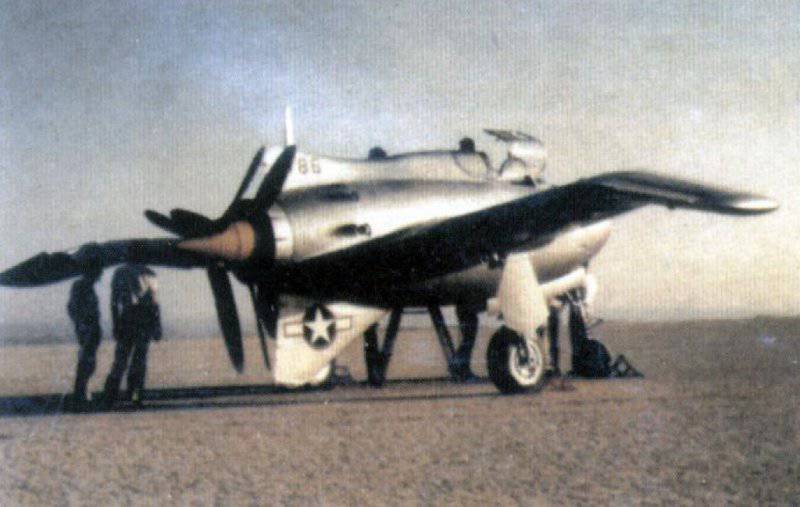
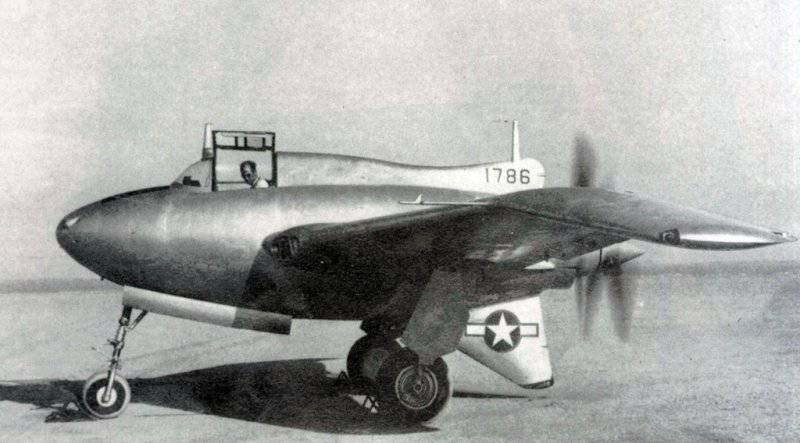
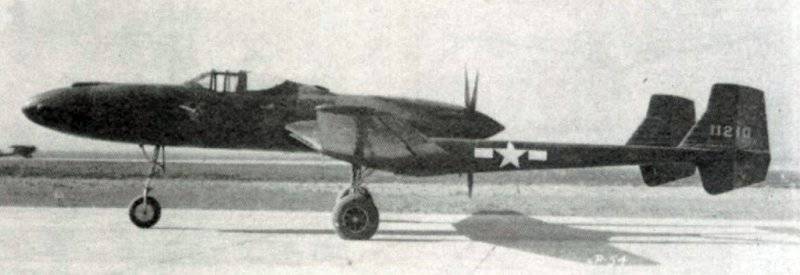
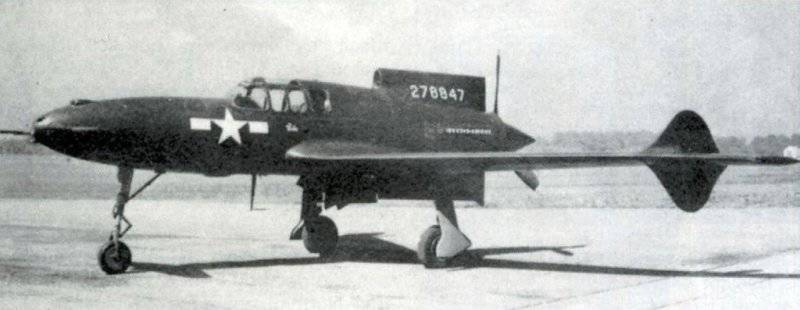
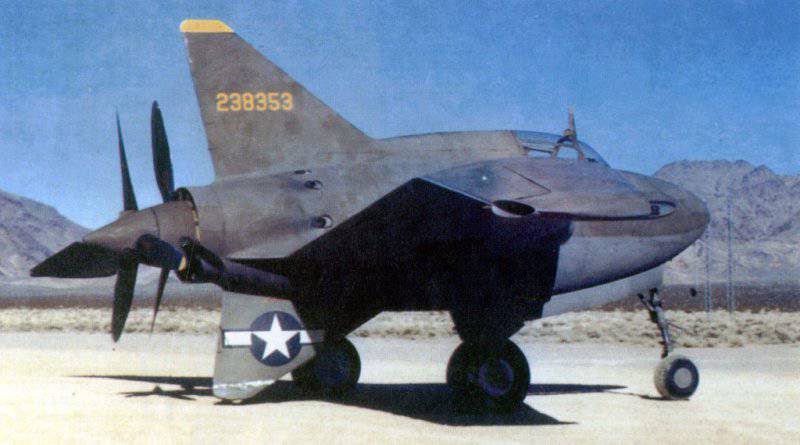
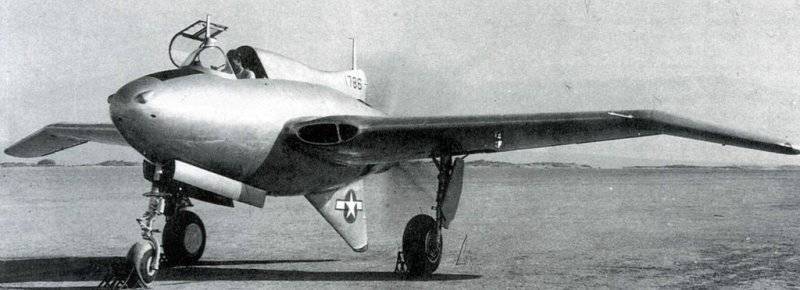


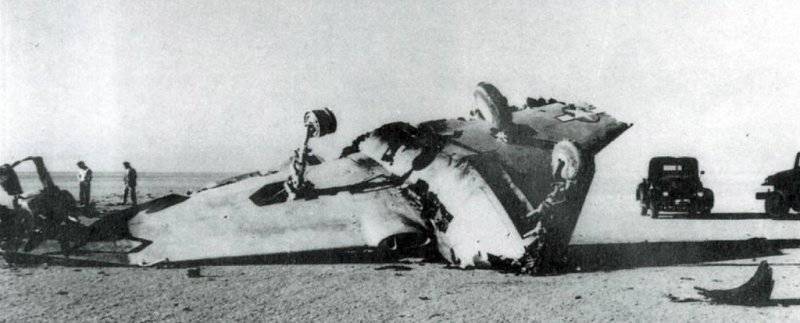
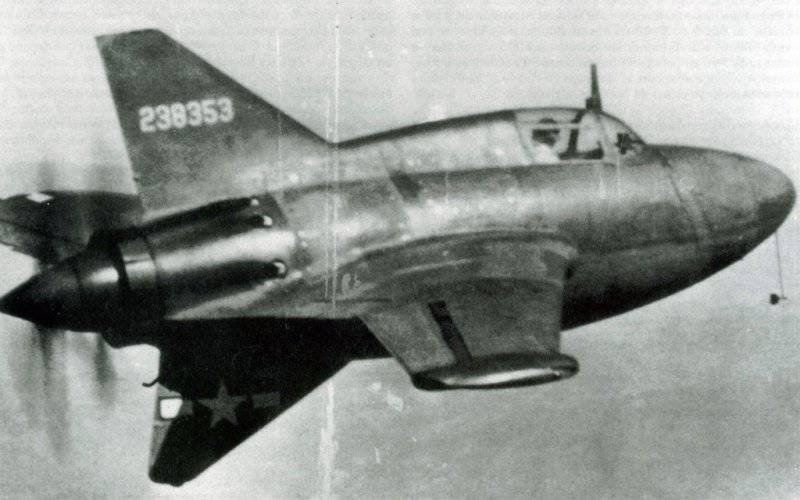
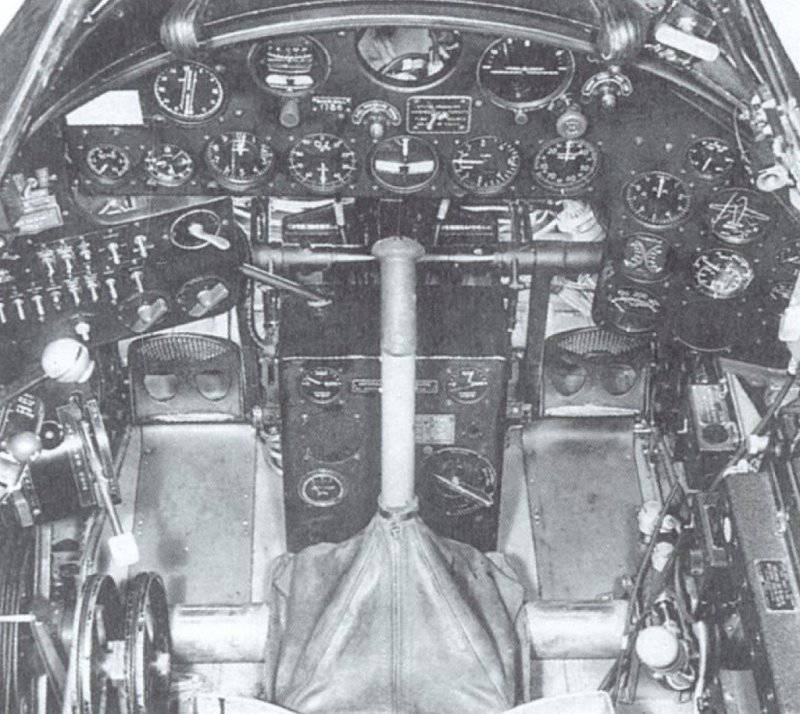
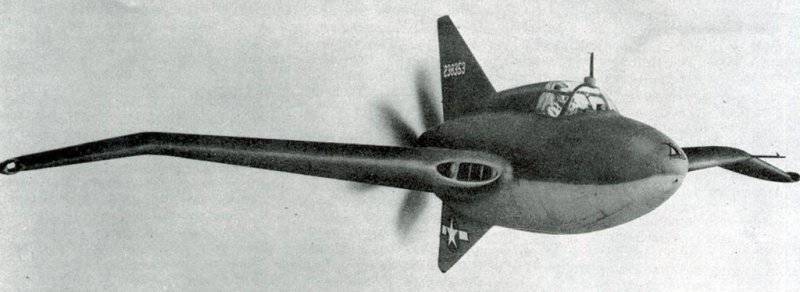
Information